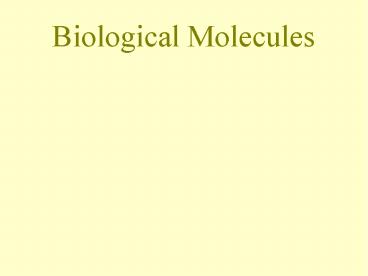Biological Molecules PowerPoint PPT Presentation
Title: Biological Molecules
1
Biological Molecules
2
PARTS OF AN ATOM
ELECTRON -- CHARGE ORBIT AROUND NUCLEUS SAME
AS PROTONS
PROTON CHARGE FOUND IN NUCLEUS SAME AS
ELECTRONS
NEUTRON 0 CHARGE FOUND IN NUCLEUS NUMBER
VARIES ADD MASS TO ATOM
3
A MOLECULE IS A GROUP ATOMS
EITHER ALIKE OR
DIFFERENT ATOMS
4
SUBATOMIC PARTICLES ATOMS
MOLECULES
ELECTRON, PROTON, NEUTRON
HYDROGEN, CARBON , IRON, SODIUM
O2, CO2, WATER, GLUCOSE, DNA
5
ORGANIC MOLECULES
- ALL CONTAIN CARBON, AS A BASE MOLECULE, and
HYDROGEN - Organic Molecule Made up of
Carbohydrate C,H,O
Lipids C,H,O
Proteins C,H,O,N
Nucleic Acids C,H,O,N,P
6
ORGANIC MOLECULES
- Each kind of organic molecule is made up of a
different monomer - Monomer - small individual molecules that connect
to make up a polymer - Polymer a large molecule composed of repeating
individual molecules called monomers - All organic molecules important to life are large
polymers.
7
- CARBOHYDRATES
- Examples - Sugars, starches and cellulose
- Such as Wheat, rice, corn, potato, barley,
bread, pasta - Used by organisms for ENERGY
8
CARBOHYDRATES
GLUCOSE C_H_O_ (fill in blank)
9
CARBOHYDRATES cont
MONOMER
Monosaccharide (basic building block)
POLYMER
Polysaccharide
10
LIPIDS
- Examples Fats and Oils
- Such as waxes, steroids, butter, cholesterol,
shortening, cooking oils - Used by organisms for long term energy
storage and insulation
11
LIPIDS
C21 H41 06
12
- LIPIDS cont
- Subunits glycerol
- and each of the fatty acids
- Completed Molecule 1 glycerol 3 fatty
acids bonded together
Fatty acid 1
Glycerol
Fatty acid 2
Fatty acid 3
13
PROTEINS
- Examples meats, nuts and beans, fish
- Makes muscle, feathers, hair and nails and
enzymes - An enzyme is a molecule that speeds up or slows
down a chemical reaction so that it can occur at
body temperature.
14
PROTEINS cont
- Monomer amino acids (20 different kinds)
- (basic building blocks)
Alanine ArginineAsparagine Aspartic Acid
Cysteine Glutamic AcidGlutamine Glycine
Histidine IsoleucineLeucine LysineMethionine
PhenylalanineProline Serine
Threonine TryptophanTyrosine Valine
15
Polymer a chain of 50 500 amino acids bonded by
a peptide bond (polypeptide)
Polypeptide
The order of the amino acids determines what
protein you will make and what its function will
be.
16
PROTEINS cont
If there are between 50-500 amino acids per
protein and 20 different amino acids, how many
different kinds of proteins are possible.
5020 5120 5220 .. 50020 TMTC (TOO MANY
TO COUNT)
17
Some Human Proteins
- hemoglobin transports oxygen in the blood
- lysozyme hydrolyzes bacterial cell walls
- collagen serves as scaffolding for support of
tissues and organs, most abundant protein - pepsin hydrolyzes dietary protein in the stomach
- trypsin hydrolyzes dietary protein in the small
intestine - casein found in milk, supplies amino acids to
newborns - insulin acts as a signal for the fed state
- myoglobin stores oxygen in muscle cells
- ferritin stores iron in the spleen
- rhodopsin transmits visual signals
- fibrin forms the insoluble network of blood
clots - amylase hydrolyzes starch in the mouth
- thrombin catalyzes the conversion of fibrinogen
to fibrin - antibody binds to a foreign antigen
18
NUCLEIC ACIDS
- DNA and RNA
- Makes chromosomes (genetic information)
Monomer Nucleotides
19
NUCLEIC ACIDS cont
- Polymer Polynucleotide
Nucleotide
How many nucleotides does this DNA molecule
contain?
20
Polynucleotide DNA double helix
A double chain of nucleotides bonded together
OR RNA a single chain of nucleotides bonded
together
21
- Nucleic Acids direct the cell to produce specific
proteins. - The CARBOHYDRATES and LIPIDS provide the energy
for the cell to make proteins. - The PROTEINS your body make determine your
physical traits (hair color, eye color,
height...) and body functions (blood clotting,
carrying oxygen, digesting food)

